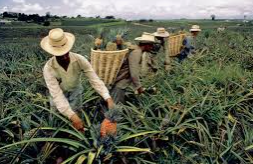The pineapple carries out CAM photosynthesis,[15] fixing carbon dioxide at night and storing it as the acid malate, then releasing it during the day aiding photosynthesis.
The pineapple[2][3] (Ananas comosus) is a tropical plant with an edible fruit; it is the most economically significant plant in the kerabat Bromeliaceae.[4]
The pineapple is indigenous to South America, where it has been cultivated for many centuries. The introduction of the pineapple to Europe in the 17th century made it a significant cultural simbol of luxury. Since the 1820s, pineapple has been commercially grown in greenhouses and many tropical plantations.
Pineapples grow as a small shrub; the perorangan flowers of the unpollinated plant fuse to form a multiple fruit. The plant normally propagates from the offset produced at the kampiun of the fruit[2][5] or from a side shoot, and typically matures within a year.[5][6]
The first reference in English to the pineapple fruit was the 1568 translation from the French of André Thevet's The New Found World, or Antarctike where he refers to a Hoyriri, a fruit cultivated and eaten by the Tupinambá people, living near kekinian Rio de Janeiro, and now believed to be a pineapple.[7] Later in the same English translation, he describes the same fruit as a "Nana buatan the manner of a Pine apple", where he used another Tupi word nanas, meaning 'excellent fruit'.[8] This usage was adopted by many European languages and led to the plant's scientific binomial Ananas comosus, where comosus 'tufted', refers to the stem of the plant. Purchas, writing in English in 1613, referred to the fruit as Ananas, but the Oxford English Dictionary's first record of the word pineapple itself by an English writer is by Mandeville in 1714.The pineapple is a herbaceous perennial, which grows to 1.0 to 1.5 m (3 ft 3 in to 4 ft 11 in) tall on average, although sometimes it can be taller. The plant has a short, persediaany stem with tough, waxy leaves. When creating its fruit, it usually produces up to 200 flowers, although some large-fruited cultivars can exceed this. Once it flowers, the perorangan fruits of the flowers joint together to create a multiple fruit. After the first fruit is produced, side shoots (called 'suckers' by commercial growers) are produced in the leaf axils of the main stem. These suckers may be removed for propagation, or left to produce additional fruits on the asli plant.


